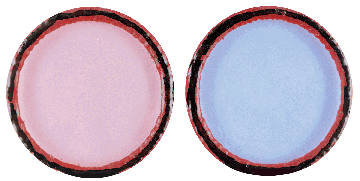

WITH A SIMPLE COLOR CHANGE from blue to red, a new monomolecular film created by LBL researchers signals the presence of influenza, offering the possibility of a quick nasal or throat swab test for viral infection.

The work is part of an ongoing research program by scientists at LBL's Center for Advanced Materials to tailor films for detecting pathogens, environmental toxins, and other targets of interest.
Materials scientist Deborah Charych developed the device with LBL chemist Jon Nagy, UC Berkeley graduate student Wayne Spevak, and former LBL scientist Mark Bednarski, who initiated the research.
The film is a significant advance in the field of biosensor research, where scientists have generally relied on elaborate combinations of antibodies coupled to electronic or optical devices to measure biologically active substances.
"Simple virus detection with the film requires little or no instrumentation," Charych says. "You just look for a color change from blue to red."
The molecule that makes up the film has a composite structure, where one part of the molecule binds the virus and the other serves as the film's backbone. The virus-binding element is a synthetic version of the cell surface sugar, called sialic acid, that serves as an attachment site on human cells for flu viruses. The synthetic sialic acid is connected to a longer diacetylene lipid, a molecule similar to the phospholipids that are the building blocks for cell membranes.
Scientists assemble the composite molecules into a layer one or more molecules thick on the surface of a glass microscope slide. Exposure to UV light links the molecules together by activating a triple bond within the diacetylene lipids, creating a blue-tinted film covered with sialic acid sugars.
Potentially infected samples are dropped directly onto the surface of the film, and any virus present binds to the sialic acid sugars. Virus binding changes the structure of the interconnected lipid chains beneath the sugars, and causes the film to absorb a different wavelength of light, i.e., change color from blue to red.
The amount of color change depends on how much flu virus is present in a sample; lower concentrations of virus generate only an intermediate purple color on the slide. Researchers can estimate the amount of virus in a sample by reading the exposed slides with a colorimeter.
"We think we can detect the virus at levels lower than what you see in a full-blown flu case," Charych says. "The next step is obtaining throat or nasal swab samples from flu patients to show that this could be an easy test to use in the field or in a doctor's office."
The researchers are also working to understand the molecular mechanisms of the color change, and to apply the sensor technology to other environmental agents.
Return to LBL Research Review Table of Contents